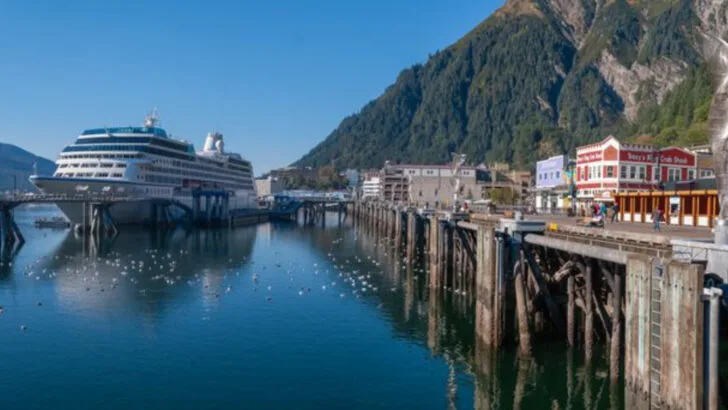Alaska, with its vast landscapes and unique culture, offers tourists an unforgettable experience. However, many visitors make common mistakes that can mar their adventures.
From underestimating the weather to misjudging distances, these errors are often easily avoidable with some planning and awareness.
In this guide, we’ll explore 13 typical pitfalls tourists encounter, helping you to prepare for a safe and enjoyable journey through the Last Frontier.
By understanding these common blunders, travelers can enrich their Alaskan experience, ensuring memories that will last a lifetime.
Underestimating the Weather
Alaska’s weather is notoriously unpredictable, even during the summer months. One moment it can be sunny, and the next, rain clouds roll in, leaving unprepared tourists drenched.
Visitors often pack lightly, expecting only mild weather, but temperatures can fluctuate significantly. Layered clothing is essential to adapt to these rapid changes. Tourists should also be aware of the potential for strong winds, especially near the coast.
By preparing for diverse weather conditions, travelers can enjoy Alaska’s beauty without discomfort or interruption.
Not Booking in Advance
Peak travel season in Alaska runs from June to August, and during this time, accommodations, tours, and rental cars fill up quickly.
Many tourists make the mistake of not reserving these services well in advance, leading to missed opportunities and exorbitant last-minute prices. Booking early not only secures your spot but often results in better deals.
Additionally, some unique experiences and excursions have limited availability and require planning months ahead. Avoid disappointment by planning and booking your key activities well before your trip.
Ignoring Wildlife Safety Rules
Wildlife is one of Alaska’s greatest attractions, but it also comes with risks. Tourists often get too close to animals like bears and moose, underestimating their unpredictability.
Many visitors focus on capturing the perfect photo, forgetting the danger posed by these majestic creatures. Following park guidelines and maintaining a safe distance is crucial.
Animals can quickly become aggressive if they feel threatened or cornered. Educating oneself on wildlife behavior and respecting their space can prevent dangerous encounters.
Skipping Travel Insurance
Travel insurance may seem like an unnecessary expense, but in Alaska, it’s a wise investment. The state’s remote areas and unpredictable weather can lead to canceled flights and tours, leaving tourists stranded.
Without insurance, these disruptions can result in significant financial loss. Policies often cover not only interruptions but also medical emergencies in isolated locations.
Having travel insurance provides peace of mind and ensures assistance in unexpected situations. Don’t overlook this crucial safety net when planning your Alaskan adventure.
Thinking Alaska is Always Icy and Cold
Contrary to popular belief, Alaska can be warm and sunny, especially during summer. Tourists often arrive overdressed, expecting icy conditions year-round, only to find temperatures reaching up to 80°F (27°C).
Packing a variety of clothing for different weather conditions is essential for comfort. Light, breathable fabrics for sunny days, and warmer layers for cooler evenings, offer the best versatility.
Understanding Alaska’s diverse climate helps travelers enjoy their visit without being bogged down by unnecessary winter gear.
Only Visiting the Cruise Ports
Cruise ports like Juneau and Ketchikan are popular stops, but they represent just a fraction of what Alaska offers. Tourists sticking to these areas miss out on breathtaking inland destinations such as Denali National Park and Wrangell-St. Elias.
These locations provide a glimpse into Alaska’s untamed wilderness, offering unique hiking and wildlife viewing opportunities.
Exploring beyond the ports allows tourists to experience a richer, more authentic side of Alaska, away from the typical tourist trails.
Not Respecting Indigenous Culture
Alaska is home to diverse indigenous cultures with rich traditions and histories. Tourists sometimes inadvertently disrespect these cultures by taking photos without permission or disregarding local customs.
Engaging respectfully with native communities enriches the travel experience and provides insight into Alaska’s cultural fabric. Visitors should take time to learn about the significance of cultural practices and seek permission before photographing people or ceremonies.
Showing respect and understanding fosters positive interactions and a deeper appreciation of Alaska’s heritage.
Misjudging Distances and Travel Time
Alaska’s sheer size often surprises tourists, leading them to underestimate travel times between destinations.
The state is larger than Texas, California, and Montana combined, making road trips lengthy and requiring careful planning. Many visitors assume they can quickly hop from one landmark to another, only to find themselves spending hours or days in transit.
Planning itineraries with realistic travel times allows for a more relaxed and enjoyable journey. Embracing the vastness is part of the Alaskan adventure.
Failing to Prepare for Mosquito Season
In Alaska, mosquitoes reign supreme during late spring and summer, especially in wetland areas. Visitors unprepared for these swarms often find themselves relentlessly bitten, turning their adventure into an uncomfortable ordeal.
Packing effective mosquito repellent and wearing appropriate clothing can significantly mitigate this annoyance. Locals often use head nets and long sleeves to fend off the persistent insects.
Being proactive about mosquito protection ensures tourists can enjoy the stunning landscapes without distraction.
Forgetting About the Midnight Sun (or Lack Thereof)
Alaska’s long summer days and extended winter nights can catch tourists off guard. During the summer solstice, some regions experience 24 hours of daylight, affecting sleep patterns for those unprepared.
Conversely, winter brings extended darkness, impacting mood and energy levels. Travelers should consider blackout curtains or eye masks to aid sleep in the summer and light therapy for winter visits.
Understanding these seasonal extremes ensures a comfortable stay and helps tourists adapt to Alaska’s unique daylight cycles.
Not Supporting Local Businesses
Many tourists default to chain stores and cruise-sponsored shops, missing the unique offerings of local Alaskan businesses.
Supporting family-owned restaurants and artisan shops not only enriches the travel experience but also benefits the community. By choosing local, visitors can savor authentic Alaskan flavors and bring home one-of-a-kind souvenirs.
This approach fosters a meaningful connection with the people and culture of Alaska. Tourists are encouraged to explore beyond the familiar chains to discover hidden local gems.
Being Unprepared for Remote Travel
Alaska’s remote regions often lack reliable cell service and Wi-Fi, a surprise for many tourists expecting constant connectivity.
Visitors relying solely on digital maps and communication tools risk becoming lost or stranded. Preparing for remote travel with physical maps, a compass, and knowledge of the terrain is vital.
Informing others of travel plans and having emergency supplies can also provide security. Embracing the adventure of Alaska’s wild and remote areas requires foresight and preparation.
Rushing the Trip
Alaska is a land of vast beauty and tranquility, best appreciated at a slower pace. Tourists attempting to cram too much into a short visit often miss the essence of the place.
The wildlife, wilderness, and serenity call for leisurely exploration. Taking time to truly experience the landscapes and cultures enriches the journey.
By slowing down and savoring each moment, visitors can create lasting memories and foster a deeper connection with the Last Frontier.

